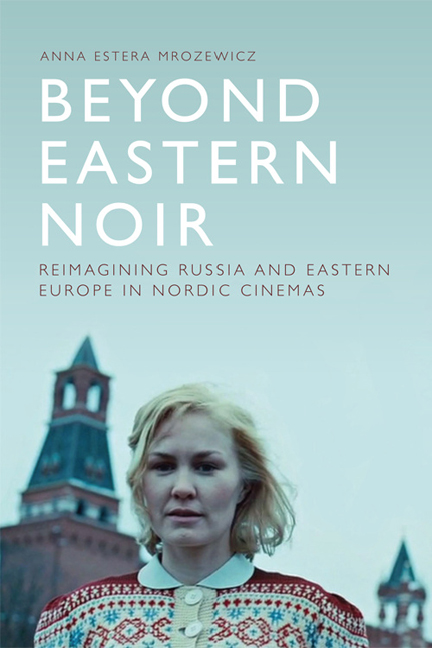Book contents
- Frontmatter
- Contents
- List of Figures
- Acknowledgements
- Introduction – The Iron Curtain Effect: Nordic Eastern Noir
- 1 Borders: Russia and Eastern Europe as a Crime Scene
- 2 Boundaries: Infiltrated Identities
- 3 The Baltic Boundary
- 4 Guilt and Shame in (Trans)national Spaces
- 5 Embodying the Fear of Russia: The Militarised Body
- 6 Polish Spectres in our House: Revisiting the Nordic Metaphor of the Home
- Afterword – Beyond Eastern Noir: Toward a New (Cinematic) Space
- Bibliography
- Filmography
- Index
5 - Embodying the Fear of Russia: The Militarised Body
Published online by Cambridge University Press: 24 April 2021
- Frontmatter
- Contents
- List of Figures
- Acknowledgements
- Introduction – The Iron Curtain Effect: Nordic Eastern Noir
- 1 Borders: Russia and Eastern Europe as a Crime Scene
- 2 Boundaries: Infiltrated Identities
- 3 The Baltic Boundary
- 4 Guilt and Shame in (Trans)national Spaces
- 5 Embodying the Fear of Russia: The Militarised Body
- 6 Polish Spectres in our House: Revisiting the Nordic Metaphor of the Home
- Afterword – Beyond Eastern Noir: Toward a New (Cinematic) Space
- Bibliography
- Filmography
- Index
Summary
As seen in several films discussed thus far, the soldier is a recurring figure in representations of Russia in Nordic cinemas. Most commonly imagined as an aggressive invader, with a green uniform, red star and military equipment as his main attributes, he encapsulates the stereotype of Russia as a brutal, despotic and expansive nation-state. At the same time, the Russian soldier can also be seen as a construction that embodies the Nordic fear of (Soviet) Russia, of which there are plentiful cinematic examples, most prominently featured in Chapter 1 of this book. This construction is often invoked in opposition to what we might call ‘homo Nordicus’ – the self-perception of the Nordic body as non- or anti-military – incorporating Nordic peacefulness as integral to its (self-)image during the Cold War (see Wæver 1992: 84–5).
Focusing on the figure of the Russian soldier for the duration of this chapter could itself appear to reinforce this negative stereotype. The aim of this chapter, however, is to investigate Nordic films that challenge this well-established narrative incarnating the ‘formula of terror and oppression exploited in countless espionage thrillers and films’ (Naarden and Leerssen 2007: 229). As we shall see, a number of films – without denying the vital role of the military in the Russian society – examine and reimagine the trope of the soldier, either by recontextualising it through the historically specific militarised body or by assuming distanced and playful approaches to the Nordic fear of Russia. Although most of these films cannot be said to possess the potential to establish a new dominant discourse – since to achieve this, they would have to enter the big-budget feature film circuit, and many of them are documentary or art-house productions, including one animation film – they are noteworthy as critical reflections on the fear of Russia, encapsulated in the figure of the soldier.
As Andrew Nestingen has put it: ‘When the nation is represented by the image of the self-sacrificing soldier, we must ask in what ways men, women, children, and groups distinct from the militarised representation of the nation are encoded in such an image’ (2013: 118). Indeed, Nordic films examine specific socio-political power structures encoded in the figure of the Russian soldier, as well as in the figures of women, children and non-militarised male bodies implicitly connected to the soldier.
- Type
- Chapter
- Information
- Beyond Eastern NoirReimagining Russia and Eastern Europe in Nordic Cinemas, pp. 143 - 168Publisher: Edinburgh University PressPrint publication year: 2018



